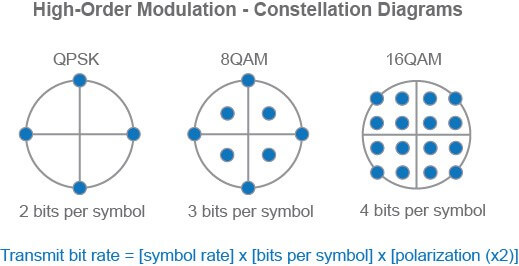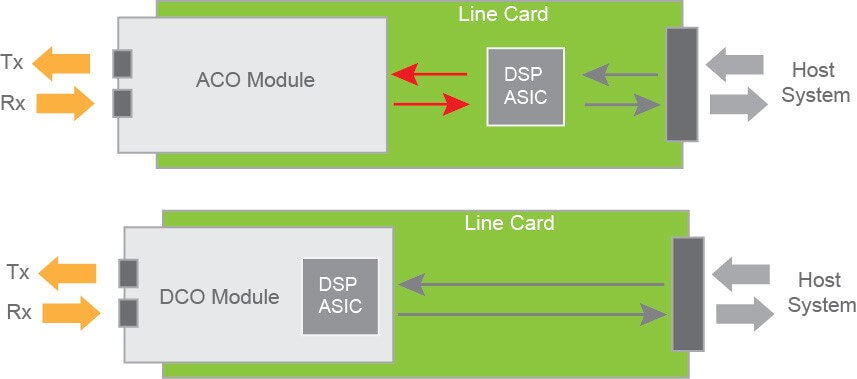Coherent Optics for Efficiency and Capacity
Coherent Optics Dominate Data Center Interconnects
This Technology Brief looks at the trend of adopting high-speed coherent optical links for data center interconnection. The technology basics behind coherent optics is covered and how it enables a greater amount of data to be transmitted over longer distances, even when using the same fiber cables.
Advances in electro-optical components and digital signal processor design have enabled coherent optic modules to increase in performance while they shrink in size. To further reduce costs and complexity, and to create true interoperable pluggable modules, new coherent optical standards are in development and promise to drive coherent optics into other applications where fiber links with greater capacity and efficiency are in demand.
How Coherent Optics Deliver More Data
In standard optical fiber communications, the optical transmission and detection is based on the intensity of the signal. The on-off modulation of the light signal carries the information from the transmitter and the receiver directly detects the signal modulation. This method has worked well for transmission rates up to 10G, but as demands for more speed and capacity over long-haul fiber links has grown, other technologies are required that can send data at rates of 100G or more on a single channel over a single fiber pair.
To achieve higher data rates, more information needs to be encoded in each transmitted symbol. Higher order modulation techniques encode information into the phase, amplitude, and polarization of the light signal rather than just the intensity. Binary phase-shift keying (BPSK), quadrature phase-shift keying (QPSK), and quadrature amplitude modulation (QAM, 8QAM, or 16QAM) are all known methods for encoding more bits per symbol. These modulation methods are used to encode bits on two polarizations of a single carrier light wave, a technique that is known as “polarization multiplexing.”

Once information has been encoded on a transmitted light signal, the problem remains how to decode that information at the receiver. The ability of the receiver to perform “coherent” detection and extract information from the phase and amplitude of the signal is the source of the term “coherent optics.” Coherent detection uses a laser tuned to a specific frequency as a local oscillator (LO) that “intradynes” with the received signal in an optical coherent mixer. The resulting signal is then passed through photodetectors to a digital signal processor (DSP) that performs analog-to-digital conversion, compensates for chromatic dispersion and polarization mode dispersion in the fiber, and recovers the transmitted bits.

The result of coherent optical communications is that much more data can be sent over a single fiber pair, and for much greater distances. Potentially, a single fiber pair can transmit Terabits of data over thousands of kilometers. Having been widely used in long-haul telecommunications for many years, coherent optics are now becoming standard for shorter-distance (up to 80 km) communications between data centers. Advances in integrated photonics (photonic integrated circuits), DSP design, and other electro-optical components has enabled high-performance coherent optics to be packaged in increasingly smaller form-factor pluggable modules.
ACO and DCO Modules
As part of the effort to develop pluggable coherent optical modules in smaller industry-standard form factors, specifically the smaller CFP2 format, the DSP chip was placed on the host line card. This enabled a better management of heat in the module, while maintaining performance at a reduced cost. This type of coherent optical module without an integrated DSP is known as “analog coherent optics” (ACO). Essentially, the coherent optical module passes an analog signal to the DSP on a host system line card.
The coherent optical modules that have the DSP integrated into the module are called “digital coherent optics” (DCO). In this case, the transceiver module passes digital data to the host system. Clearly, DCO modules have the advantage of being more interoperable and able to plug into any host system that accepts the module form factor.

Note that in older ACO/DCO CFP2 modules and line cards there was no interoperability between DSPs from different vendors, a coherent optical link had to be formed using the same DSP solution at both ends of the link. This means that older DCO transceiver modules at both ends of a link needed to be from the same vendor. Also, older ACO transceiver modules needed to not only be from the same vendor, but also needed to be plugged into compatible line cards with the same DSP.
The Move Towards Coherent Optical Standards
In the past, coherent optics was only considered cost-effective for ultra-long-haul communication links. As technologies have improved and pluggable form-factors become feasible, costs have also fallen and coherent optics have become an attractive option for other applications. However, current coherent optical solutions are not interoperable between vendors, so initiatives are in progress for 400G coherent optical standards that are targeted for data center interconnects and metro Ethernet networks.
The Optical Internetworking Forum (OIF) is developing 400ZR, a 400G coherent optical implementation agreement that will support links from 80km up to 120km. The standard uses dual polarization 16QAM modulation at a 60 Gbaud symbol rate and dense wavelength division multiplexing (DWDM). The target for 400ZR is to produce a truly interoperable DCO pluggable module that will reduce cost and complexity of high-bandwidth coherent optical links. The challenge for DSP and photonic integrated circuit suppliers will be to meet tight size and performance specifications that enable a design to fit into a standard small form-factor, such as QSFP-DD or OSFP modules.
In addition, the Institute of Electrical and Electronics Engineers (IEEE) has formed a Task Force to leverage the 400ZR specifications into its own coherent optical standard, IEEE P802.3cw 400GBASE-ZR. When modules are available for these new standards, it will enable coherent optical transceivers to plug directly into standard Ethernet switches, opening up other applications in addition to data center interconnection, such as telecommunication backhaul, distributed campus, and other metro Ethernet links.
Coherent Optics to Find Other Applications
As data center traffic volumes increase each year, the demands on data center interconnects also grow. Using coherent optical technologies to meet the bandwidth and distance requirements has become standard for these links. Coherent optics transports more data over a single fiber for greater distances using higher order modulation techniques, which results in better spectral efficiency and lower power consumption.
Significant technology advances in photonic integrated circuits and DSP design have enabled transceiver modules to fit into smaller form-factors as speeds increase from 100G to 400G and above. To reduce costs and complexity, as well as to create true interoperability, new coherent optical standards such as 400ZR and 400GBASE-ZR are in development and promise not only to meet data center interconnect needs, but also drive coherent optics into backhaul, distributed campus, and other metro Ethernet applications.

